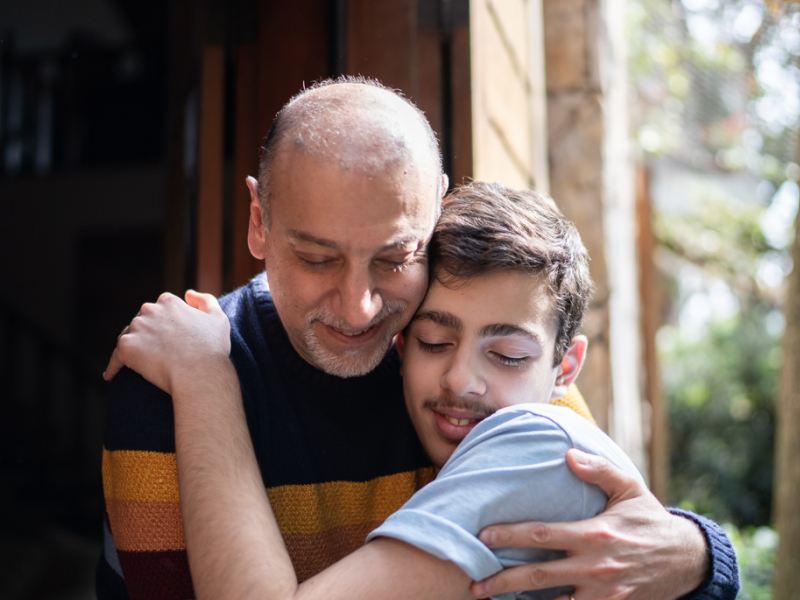
Table of Contents
Is It Autism or ADHD?

Written By: Alex Bachert, MPH

Clinically Reviewed By: Dr. Don Gasparini
March 28, 2024
5 min.
ADHD and autism are distinct neurodevelopmental disorders that share some overlapping symptoms. We unpack the differences (and similarities) below.
Learn more about our Clinical Review Process
Table of Contents
Attention-deficit/hyperactivity disorder (ADHD) and autism spectrum disorder (ASD) are both neurodevelopmental disorders that begin during childhood and contribute to cognitive, social, and behavioral challenges throughout life. Neurodevelopmental disorders are linked to neurodivergence, a term that means a person’s brain functions differently from the “typical” brain. Below, we dig into the differences and similarities between ADHD and autism, comparing rates of prevalence, symptoms, and treatment.

We specialize in neurodivergent-affirming care
Intensive mental health treatment with others who get it.
What is ADHD?
ADHD is a developmental disorder that can cause problems with attention, hyperactivity, and impulse control. It’s usually first diagnosed in childhood but can continue through adolescence and into adulthood. There are three types of ADHD: inattentive type, hyperactive-impulsive type, and combined type. Depending on the type of ADHD, adolescents and young adults with ADHD may struggle with inattention symptoms (difficulty listening or getting easily distracted) or hyperactivity and impulsivity symptoms (talking excessively or fidgeting).
What is autism spectrum disorder?
ASD, also known as autism, is a neurodevelopmental condition that affects people’s ability to communicate, connect, and interact with others. As its name suggests, autism is a spectrum disorder, which means that it affects people in different ways. While some people have mild symptoms and require minimal support, others have more debilitating symptoms that require significant resources to manage. As such, signs and symptoms of autism can range from difficulty reading social cues to emotional dysregulation.
Autism vs ADHD: a look at the data
Research suggests that approximately 15 to 20% of the world’s population exhibits some form of neurodivergence. Both ADHD and autism are common conditions here in the U.S., but the rates differ between the conditions.
ADHD is one of the most common neurodevelopmental disorders diagnosed in children, with approximately 9.4% of U.S. children ages 2 to 17 receiving an ADHD diagnosis at some point in their life. Autism rates are lower in the U.S., with 2023 data suggesting that one in 36 8-year-olds have autism. However, rates of autism are on the rise: previous data collected from 8-year-olds found that only one in 44 children had autism.
You may be wondering if it’s possible to have both ADHD and autism, and the short answer is yes. Research shows that 20 to 50% of children with ADHD also meet the diagnostic criteria for autism, while 30 to 80% of children with autism may also have ADHD.
What is the difference between ADHD and autism?
As mentioned, ADHD and autism are two distinct neurodevelopmental disorders that share some common symptoms. And while the conditions may seem similar at first, learning how to recognize the differences is essential for an accurate diagnosis and appropriate treatment. Below, we highlight some of the overlapping symptoms of ADHD and autism, as well as the key distinguishing features of each.
1. Impaired social skills
ADHD and autism can both lead to impaired social skills in children and adolescents. For example, people with ADHD and autism may struggle to understand social cues or make and maintain appropriate relationships.
However, there are a few differences. People with ADHD can typically have reciprocal conversations and interactions with others, while autistic individuals may struggle to articulate their thoughts and feelings or make eye contact during a social interaction.
2. Attention and distractibility
We often think of limited attention span as an ADHD trait, but teens and young adults with autism can also have problems with attention and distractibility. People with autism may struggle to focus on activities they don’t enjoy but will often fixate on things they do like.
One way to help notice the difference is to watch someone do their homework. Someone with ADHD may struggle to pay attention to any subject, while an autistic person is more likely to remain engaged with their favorite topic.

3. Hyperactivity
Hyperactivity, defined as increased movement, impulsive actions, and a shorter attention span, is another defining ADHD trait that can also be observed in people with autism. For example, both conditions can cause stimming—repetitive, self-stimulating behaviors. People with ADHD may stim to help improve focus and control their impulses, while people with autism often stim to relieve anxiety.
Examples of ADHD stimming include repeating sounds, constant throat clearing, rubbing fingers, and spinning, while autistic stimming may look like hand-flapping, rocking, humming, and pacing.
4. Executive functioning
Another similarity between the two conditions is limited executive functioning. Recent research found that people with both ADHD and autism had worse attention, flexibility, working memory, processing speed, and response inhibition than typically developing individuals.
5. Co-occurring mental health conditions
ADHD and autism often co-occur with other mental health conditions and developmental disorders, which can complicate the diagnosis. Examples include depression, anxiety disorders, learning disabilities, and speech and language disorders.
6. Repetitive behaviors
There are several autistic traits that aren’t typically associated with an ADHD diagnosis. For example, restricted and repetitive behavior is common with autism but not ADHD. Teens and young adults with autism may have an intense preoccupation with specific topics or interests, following a routine, or sensory sensitivity.

How does treatment for ADHD and autism differ?
The first step in treating ADHD, autism, or any other condition is to receive an accurate diagnosis. If you suspect that you or someone you know has a neurodevelopmental disorder, it’s important to receive a comprehensive assessment from a qualified healthcare professional, such as a psychiatrist, psychologist, or pediatrician.
From there, a professional can make a treatment plan, which varies based on the diagnosis and a person’s unique needs. Treatment for ADHD typically involves medication and behavioral therapy to improve focus and impulse control, along with education and support from caregivers. On the other hand, autism treatment focuses on behavioral therapies to teach positive behaviors, speech and language therapy for communication challenges, and occupational therapy to improve daily functioning. Medications may be used in autism treatment for associated symptoms like anxiety or depression. Education and support are vital for both conditions, but other treatment approaches vary.
How can Charlie Health treat neurodevelopmental disorders?
Navigating life with ADHD, autism, or another neurodevelopmental disorder can be challenging. That’s why Charlie Health offers a virtual intensive outpatient program (IOP) for teens, young adults, and families dealing with serious mental health conditions — including in neurodiverse people. Charlie Health’s team of compassionate mental health professionals practice neurodivergence-informed therapy and celebrate each person’s unique differences. At Charlie Health, every client is matched with a therapist who fits their specific needs, as well as a group of peers from similar backgrounds with similar struggles. Fill out the form below or give us a call to start healing today.
References
https://www.nimh.nih.gov/health/topics/autism-spectrum-disorders-asd
https://www.autism.org.uk/advice-and-guidance/what-is-autism
https://www.hopkinsmedicine.org/health/conditions-and-diseases/adhdadd
https://circlecareservices.com/autism-vs-autism-spectrum-disorders-what-is-the-difference/
https://chadd.org/adhd-weekly/stimming-and-fidgeting-helps-some-people-with-adhd-to-pay-attention/
https://www.ncbi.nlm.nih.gov/pmc/articles/PMC6331660/
https://www.nimh.nih.gov/health/publications/adhd-what-you-need-to-know
https://www.cdc.gov/mmwr/volumes/72/ss/ss7202a1.htm?s_cid=ss7202a1_w




